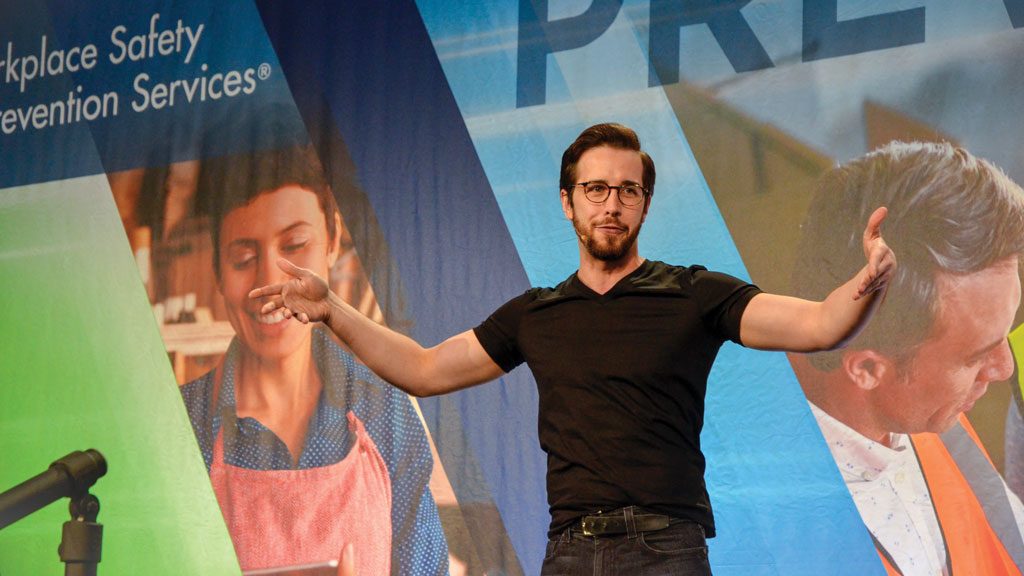“By the time I got to a bridge late one night, many years later after that initial struggle, I had been struggling for a very long time. After I climbed up over the railing of the bridge and stood on about an inch and a half of concrete, I thought to myself this is the end, this is it. I’m 15 years old and I can’t see anything beyond that. I can’t see possibly having a different life, a better life. How things are right now are how things will always be.”
That was a story shared by Mark Henick, mental health advocate, during his talk at the Partners in Prevention Health and Safety conference May 1 in Mississauga, Ont.
Henick discussed his personal struggle with mental health and suicide as a young boy growing up in Sydney, N.S.
“I’m going to share these stories about my suicidal ideation because a lot of people deal with these kinds of issues,” said Henick.
“I really think it’s important that you walk out of here with some tools and a better appreciation for the small moments in your life that can really make a difference, not only for how you feel but how you interact with your coworkers, your peers, even your supervisors, those who you might supervise everybody in your workplace, and how even the simplest little interactions can make a huge difference.”
Henick recalls starting to feel suicidal before the age of 10. He described to the audience two incidents which stood out for him: when he drew 10 ways he could kill himself on the side of a test and the time he asked a teacher to borrow a knife so he could hurt himself and proceeded to pull out that knife and hold it to his throat in front of the guidance counsellor.
“For me since I didn’t understand my own problems, the solution for me was to end my life, to escape,” explained Henick. “It was never about dying it was always about escaping the problems because I had no other skills to deal with it.”
Having the supports people need in place is key, he noted.
“We’re always saying reach out, speak up if you’re struggling, but the second half of that is what if there is nobody reaching back? What if we actually don’t have the resources in our communities or in our workplaces to give people the help that they need?” asked Henick.
People don’t go just anywhere to commit suicides and there are what are known as “suicide hotspots.” In Toronto, it used to be the Bloor-Danforth Viaduct on the Don Valley Parkway, before the luminous veil suicide prevention barrier was built.
All it takes is a few simple words or someone reaching out to convince you that this does not have to be the end,
— Mark Henick
Mental Health Advocate
“What this shows us is that suicide prevention works and there are a number of different ways to do it and one of those ways is called means restriction,” stated Henick. “If you actually make it harder for people to kill themselves when they are in that impulsive place, then it sometimes gives them time to rethink.”
He said he chose to end his life on the bridge overlooking the steel plant for a reason. He went there alone because he didn’t want anyone to stop him.
“This place used to be so vibrant, it used to provide the livelihood for my entire family, my entire hometown and here it sat alone and empty, dark and abandoned,” Henick said.
“I climbed up over the railing and I held the telephone pole that was on my left-hand side and I held it because I didn’t want to slip and fall as I climbed over the railing to jump off the bridge. I didn’t want it to be an accident.”
When you get into a crisis with extreme emotion, everything else fades away.
“The problem with mental health crisis is that we zoom in on that moment so tightly that we can’t zoom back out, we stay stuck in that place,” Henick explained.
What kept him on the edge of an inch-and-a-half of concrete for a few minutes was the unusual feeling of control.
“I had no control over anything else in my life but I do have control over whether or not I’m alive,” he remembers thinking to himself. “As I stood there, the blinders started to soften a little and as they did I was interrupted by a voice over my shoulder. It was a man in a light brown jacket. He said ‘you don’t look like you’re doing so good there.’ ”
He thinks he remembers hearing a group of men off to the side and one of them shouted “jump you coward.”
“In that ambivalent place, going back and forth on this balance, both on the edge and in my mind, I decided that was all the information I needed,” said Henick. “When he told me to jump I let go of the railing, I started to fall…and then I saw the stranger’s light brown jacket as he rushed towards me and wrapped his arms around my chest.”
Henick was sent back to the basement psych ward where he had been so many times before.
“For me while nothing in my treatment environment had changed something inside me had changed,” he said. “Maybe I actually had some say in who I got to be when I leave this place this time, maybe I don’t have to be the victim.”
That moment taught him that he can choose what he did with his story.
“I can be the guy who has others backs, the stranger who connects and reaches out and saves peoples’ lives,” said Henick. “When I realized I wanted to do that it gave me an energy that I didn’t know that I had inside of me.”
After that he asked the principal of his high school if he could tell his story, when the principal said no, he contacted the newspaper and the next day there were TV crews in the principal’s office.
“I felt like everybody knew already and everyone else was telling me my story, everyone else was narrating to me and my story was mine,” said Henick.
“When I opened up like that people came to me. They wanted to share their story too. I was blown away because before that nobody wanted to talk to me about my experience or theirs.”
About six years ago Henick was invited to do a Ted Talk on his experience a dozen years earlier and it went viral, but he felt like an imposter.
“I didn’t know who the stranger in the light brown jacket was who I was modeling my life after,” said Henick.
A week after the Ted Talk he went on TV asking for the public’s help and found the stranger. The stranger, named Mike, sent him an email.
“To have him relate my story back to me meant my story was real, that it actually did happen,” Henick noted.
“How do you thank somebody for not only saving your life but for giving you your whole life since? The best I could do was to introduce him to the life he had given me, the life he made possible…I showed him all the things that I never thought were possible when I was locked into that moment on the edge of the bridge.”
He added, “When things seem impossible, when things seem their most stuck, like nothing will ever get better you need to know that it can, that sometimes all it takes is a few simple words or someone reaching out to convince you that this does not have to be the end.”











Recent Comments
comments for this post are closed